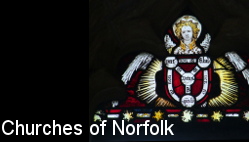
home I index I latest I glossary I introductions I e-mail I about this site
St John the Baptist, Coltishall
Follow these journeys as they happen on X/twitter.
St John the Baptist, Coltishall Coltishall is a busy little place, and was once busier. It grasps hands with its twin village of Horstead across the River Bure. The large riverside pub on the east side of the village is a popular summer stopping off point for boats on the Broads, but at any time of the year Coltishall has the feel of somewhere where people actually live and work. Its tall and rather stark church of St John the Baptist sits hard against the main road, the long lines of its continuous nave and chancel softened by a roof of thatch. The tower can be fairly accurately dated to the last few decades of the 15th Century, when a flurry of bequests transcribed by Paul Cattermole and Simon Cotton refer to it. I 1459, Peter at Lane had left 6s 8d to the tower, on the condition that the parishioners agreed to proceed with the work. However, by the 1470s work had clearly begun in earnest, with a succession of bequests including William Ocle's 1474 gift of three bushels of malt. By 1507 there were bequests to the bells, suggesting that by then the tower was complete. However, take away the tower and you can see at once that the rest of the church is an ancient structure, almost entirely a 13th Century rebuilding of what had been a Norman, and possibly even Saxon church. The two filled in circular openings in the upper part of the north nave wall certainly look as if they might have been Saxon windows, although as Pevsner notes they are curiously high. Below them, a large modern round window apes them, probably cut through in the restoration of 1865. It must be said that the church feels somewhat hemmed in on this side, but to the south the churchyard is wide and open, a quite different perspective. You enter the building from the west, unusually in East Anglia, and the low ceiling creates a tunnel-like effect beyond you, although the addition of the south aisle ameliorates this with some sense of space. The predominantly clear glass allows the white walls and ceiling to glow. The square late 12th Century Purbeck marble font dominates this end of the church under a neat little 17th Century gallery shoe-horned into the space beneath the tower. The modern round window was filled with memorial glass to the Morse family in about 1960. This includes the reuse of a large 17th Century Flemish roundel depicting the head of St John the Baptist being displayed by Salome to her mother Herodias and her stepfather Herod Antipas. Birkin Haward says that the glass was the work of Alfred Wilkinson for King & Son. There are a couple of minor 19th Century windows in the nave, but more imposing is the east window by Powell & Sons of about 1920 depicting the Risen Christ flanked by angels and saints above a small scene of the Nativity. Haward points out that there are surviving fragments of 19th Century glass in upper lights of most other windows. The 18th Century brought some grand memorials, a reminder that Coltishall was a wealthy little town in those days. Its main industries were malting and boat-building, for both of which it was handily placed on this navigable stretch of the Bure, but these fell away during the course of the 19th Century. As Pevsner poignantly observes, the last wherry was built in the once-thriving Anchor Street boatyards in 1912 and the last malthouse closed in 1927, and the rows of once fashionable shops closed with them. Simon Knott, February 2024 Follow these journeys as they happen on X/twitter. |
|
||||||||||||||||||||||||||||||||||||||||||||||||||||||
home I index I latest I introductions I e-mail I about
this site I glossary
Norwich I ruined churches I desktop backgrounds I round tower churches
links I small
print I www.simonknott.co.uk I www.suffolkchurches.co.uk